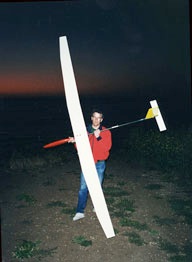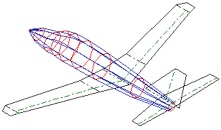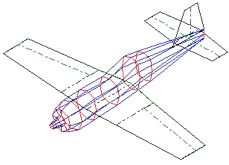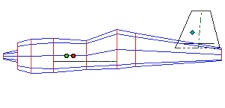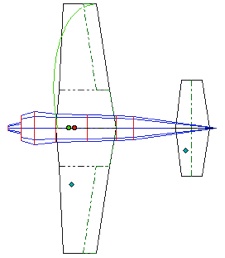Plane Geometry Overview

Introduction
Plane Geometry is a proven package of related computer spreadsheets that assist the modeler in the preliminary design of model airplanes of all types including free flight, U-control, R/C power models and R/C sailplanes.
Plane Geometry is inexpensive and fun to use. A key feature is a real-time wire frame image of the airplane that can be viewed from any angle. This provides important aesthetic feedback that is so important to designers who rely on their "eye".
Plane Geometry helps to answer time-honored modeler questions such as:
•Where should I put the center of gravity?
•How big should the tail be?
•How should I taper the wing?
•How long should the tail arm be?
•Will this airplane make a good scale subject?
•How do I design a V-tail?
•How much dihedral do I need?
•How much wing and tail incidence is right?
Plane Geometry is a series of spreadsheets in the Microsoft Excel format. If you have Excel you can run Plane Geometry. The spreadsheets feature open architecture - all of the formulas are visible. The structure is organized and modular. It is easy to modify or make additions.
Plane Geometry comes with extensive, illustrated instructions.
Plane Geometry is delivered via email.
What Do You Get?
Plane Geometry is six separate spreadsheets and an instruction booklet.
•MeasureC is used to calculate geometric characteristics of existing airplanes from simple measurements. MeasureC is for airplanes with conventional tail surfaces.
•MeasureV is the same as MeasureC except that it is for airplanes with V tails.
•DesignC is the inverse of MeasureC. Its inputs are the airplane's desired geometric characteristics and its outputs are the dimensions that give those characteristics.
•DesignV is the same as DesignC except that it is for airplanes with V tails.
•Planes is a database of some 34 different airplanes. The data is in the form of the input tables for the program, so the data can easily be pasted into the program, explored and manipulated. "Planes" also includes tabulated and plotted data on all the airplanes as well as a wireframe picture of each airplane.
•RadGyr is a simple program to calculate the mass radius of gyration of models from simple experimental measurements. This information is useful in estimating flight characteristics.
•30 pages of detailed, illustrated instructions are provided. The instructions aid the novice designer while explaining the finer points to the more experienced. The instructions are supplied electronically in the Adobe Acrobat .pdf format. You can print them out using your own printer (black and white or color works fine), or simply view them on the computer screen. Adobe Acrobat .pdf files can be read by any computer system using Adobe's Acrobat Reader software that Adobe distributes for free over the Internet.
MeasureC and MeasureV are usually used to study existing designs with conventional tails and V-tails, respectively.
•Inputs to Measure are dimensions that may come from small three view drawings, model plans, actual models or full size airplanes.
•Outputs include a classic characteristics data block, stability and control data, and a wire frame illustration of the airplane that may be viewed from any angle.
•Measure creates a data block that matches the input block of Design so that measured data can be pasted into Design for modification and more detailed analysis.
DesignC and DesignV are used to modify existing designs or create new ones with conventional and V-tails.
•Inputs to Design are mostly in the form of geometric ratios so that the size and proportions of the airplane can be altered with just a few changes to the inputs.
•Outputs include the classic characteristics data block, airplane dimensions and coordinates, stability and control data, and a wireframe illustration of the airplane that can be viewed from any angle.
•Stability and control outputs include:
◦Pitch stability and damping
◦Wing and tail incidence and lift coefficients
◦Equivalent dihedral angle, spiral stability and roll rate
◦Elevator and rudder control power
Limitations
•Plane Geometry works best with aft-tail airplanes that are left-right symmetric. Fuselage effects on stability is accurately estimated with Multhopp's method, but no provision is made for nacelles and propellers. Aeroelastic effects are not included.
System Requirements
-
•"Plane Geometry" runs on any computer that runs Microsoft Excel version 4 or higher. Plane Geometry runs without macros.
